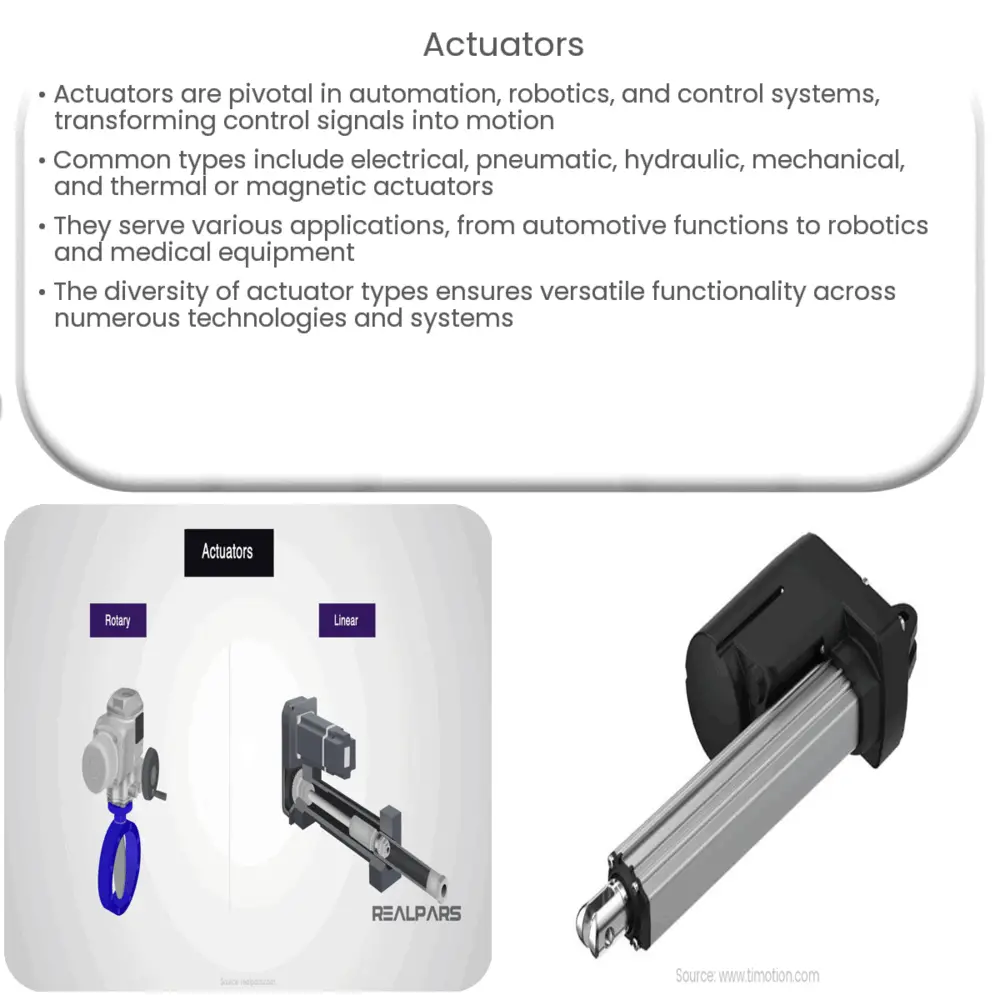Explore the world of actuators – their types, functionality, and applications across industries like automotive, automation, and robotics.

Introduction to Actuators
Actuators play a fundamental role in the world of automation, robotics, and control systems. Simply put, an actuator is a type of device or mechanism that can move or control a system. It acts in response to a control signal and does some kind of work. Actuators are typically used in industrial or mechanical applications and are designed to help automate different types of systems.
Types of Actuators
There are various types of actuators available today. Some of the most commonly used ones include:
- Electrical Actuators
- Pneumatic Actuators
- Hydraulic Actuators
- Mechanical Actuators
- Thermal or Magnetic Actuators
Electrical Actuators
Electric actuators are widely used due to their precision, control, and power. They convert electrical energy into mechanical motion. Common types of electric actuators include motors and solenoids. Motors can be AC or DC and include types like stepper motors and servo motors. Solenoids, on the other hand, use the magnetic field generated by an electric current to create motion.
Pneumatic Actuators
Pneumatic actuators use compressed air to produce motion. These actuators have various applications, including those that demand a significant amount of force and less precision, such as opening and closing large valves or doors. Pneumatic actuators offer the benefits of high speed and force, with relatively simple design and operation, but they require a source of compressed air and may not be suitable for environments where precision and control are crucial.
Hydraulic Actuators
Hydraulic actuators leverage fluid power to accomplish work. They offer high force capability, making them ideal for lifting heavy loads or where substantial force is needed. Hydraulic actuators provide excellent precision and control, but they involve more complex setups than electric or pneumatic actuators, often requiring a pump, reservoir, and fluid lines.
Mechanical Actuators
Mechanical actuators convert mechanical motion into another type of motion. These are often manually operated and involve mechanisms such as screws, wheels, cams, and gears. Examples include car jacks, push buttons, and switches. Mechanical actuators are used in applications where manual control is preferable or where there is no electricity, pneumatic or hydraulic power.
Thermal or Magnetic Actuators
Thermal actuators rely on the principle of expansion and contraction caused by temperature changes. They are often used in temperature control systems such as thermostats. Magnetic actuators, similar to solenoids, operate based on magnetic fields but tend to be more specialized, working under the principles of magnetic attraction and repulsion.
Applications of Actuators
Actuators are crucial in a multitude of applications across various industries:
- Automotive industry: From fuel injection systems to power windows and automatic door locks, actuators play a significant role.
- Industrial automation: Actuators help in automating processes such as opening and closing valves or doors, positioning machine tools, etc.
- Robotics: Actuators enable movement and interaction in robotic systems.
- Aerospace: In this industry, actuators control the wing flaps, rudders, and other flight control surfaces.
- Medical Devices: Actuators are used in a variety of medical equipment such as surgical robots, patient lifts, and drug delivery systems.
Conclusion
In conclusion, actuators are a critical component in numerous systems and technologies that we interact with daily. Their diverse types – electrical, pneumatic, hydraulic, mechanical, and thermal or magnetic – provide the functionality and versatility needed across a broad range of applications. Understanding their operation and applications can help us appreciate the intricate technology behind our modern conveniences, from the simple action of a button press to the complex movements in automated systems and robotics.

